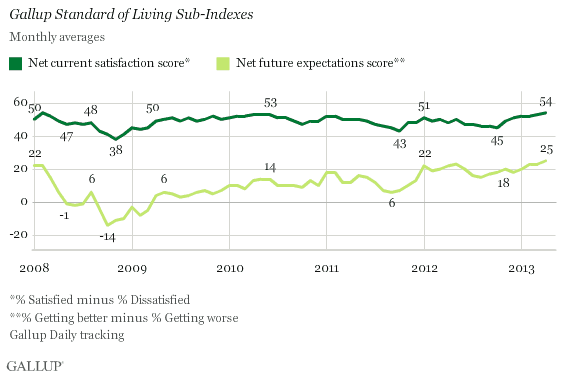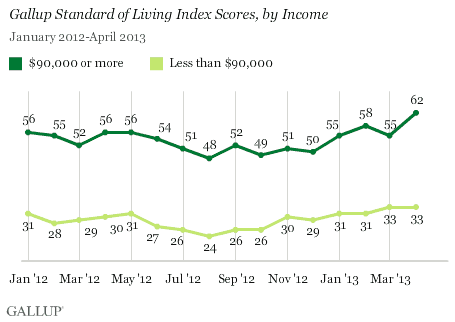WASHINGTON, D.C. -- Gallup's U.S. Standard of Living Index climbed to 40 in April, the highest monthly average in the five years Gallup has tracked this measure. The current score is up slightly from 38 in March and 35 in April of 2012.

Americans' evaluations of their standard of living declined during the financial crisis in 2008 to a low of 14 in October and November of that year. Standard of living perceptions improved throughout 2009 and 2010, but slipped in the summer of 2011 after the stock market reacted negatively to the debt ceiling deal and downgrading of the U.S. credit rating. Americans' standard of living assessments rebounded and generally continued to improve in late 2011 and the first half of 2012. They dipped in the summer of 2012, but generally have improved since.
These results are based on Gallup Daily tracking interviews, conducted by landline and cellphone, with more than 15,241 Americans from April 1-30, 2013. Gallup's Standard of Living Index is based on Americans' ratings of their satisfaction with their current standard of living and their assessments of whether it is getting better or getting worse.
Both components of the index improved this year. The net current satisfaction score for April is 54 -- based on 77% of Americans saying they are satisfied with their standard of living and 23% saying they are dissatisfied. That net score of 54 matches the highest monthly average on record from February 2008.
Meanwhile, 54% of Americans say their standard of living is getting better and 29% say it is getting worse. That results in a 25 net expectations score, also the best score in Gallup's five-year history on this index.
Americans were more likely to rate their standard of living as getting worse than getting better in all but one month from May 2008 through March 2009, but have since been more likely to say their standard of living is getting better than getting worse.

Upper-Income Americans' Standard of Living Perceptions at Five-Year High
Upper-income Americans' Standard of Living Index score is consistently higher than middle- and lower-income Americans do. But scores for both income groups are as high now as they have been at any point in the last five years. The Standard of Living Index score for upper-income Americans in April is 62, a five-year monthly high. The index score for middle- and lower-income Americans is 33, tied with March as the best Gallup has on record for this group.

Bottom Line
Americans' overall perceptions of their current and future standard of living in April were better than in any month in the past five years, even prior to the financial crisis. This upward trend also mirrors Americans' growing economic confidence, which in April rose to tie the five-year monthly high. Similarly, Americans' financial worry has dipped to the lowest level since before the recession. These improvements in Americans' assessments of their standard of living, the U.S. economy, and their personal finances in 2013 are likely due higher stock prices, elevated housing prices, and lower gas prices.
Additionally, Americans across all income levels are as positive about their standard of living now as they have been at any point in the past five years. If this continues, it could translate into increased consumer spending -- beyond the increases Gallup has already seen since late 2012 -- and economic growth in the months ahead.
Survey Methods
Results for this Gallup poll are based on telephone interviews conducted April 1-30, 2013, on the Gallup Daily tracking survey, with a random sample of 15,241 adults, aged 18 and older, living in all 50 U.S. states and the District of Columbia.
For results based on the total sample of national adults, one can say with 95% confidence that the margin of sampling error is ±1 percentage points.
Interviews are conducted with respondents on landline telephones and cellular phones, with interviews conducted in Spanish for respondents who are primarily Spanish-speaking. Each sample of national adults includes a minimum quota of 50% cell phone respondents and 50% landline respondents, with additional minimum quotas by region. Landline telephone numbers are chosen at random among listed telephone numbers. Cell phones numbers are selected using random digit dial methods. Landline respondents are chosen at random within each household on the basis of which member had the most recent birthday.
Samples are weighted to correct for unequal selection probability, nonresponse, and double coverage of landline and cell users in the two sampling frames. They are also weighted to match the national demographics of gender, age, race, Hispanic ethnicity, education, region, population density, and phone status (cellphone only/landline only/both, cellphone mostly, and having an unlisted landline number). Demographic weighting targets are based on the March 2012 Current Population Survey figures for the aged 18 and older U.S. population. Phone status targets are based on the July-December 2011 National Health Interview Survey. Population density targets are based on the 2010 census. All reported margins of sampling error include the computed design effects for weighting.
In addition to sampling error, question wording and practical difficulties in conducting surveys can introduce error or bias into the findings of public opinion polls.
For more details on Gallup's polling methodology, visit www.gallup.com.
